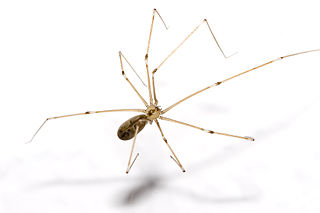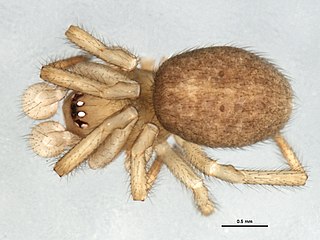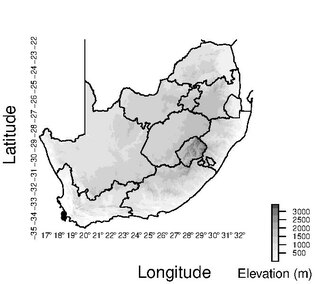
The Mygalomorphae, or mygalomorphs, are an infraorder of spiders. The name is derived from the Greek mygalē, meaning "shrew", plus morphē meaning form or shape. An older name for the group is Orthognatha, derived from the orientation of the fangs which point straight down and do not cross each other. In 1802, C. A. Walckenaer separated mygalomorph spiders into a separate genus, Mygale, leaving all other spiders in Aranea.

Huntsman spiders, members of the family Sparassidae, are known by this name because of their speed and mode of hunting. They are also called giant crab spiders because of their size and appearance. Larger species sometimes are referred to as wood spiders, because of their preference for woody places. In southern Africa the genus Palystes are known as rain spiders or lizard-eating spiders. Commonly, they are confused with baboon spiders from the Mygalomorphae infraorder, which are not closely related.

The Pholcidae are a family of araneomorph spiders. The family contains over 1,800 pholcids, including those commonly known as the marbled cellar spider, daddy long-legs spider, carpenter spider, daddy long-legger, vibrating spider, gyrating spider, long daddy, and skull spider. The family, first described by Carl Ludwig Koch in 1850, is divided into 94 genera.

The Goliath birdeater belongs to the tarantula family Theraphosidae. Found in northern South America, it is the largest spider in the world by mass – 175 g (6.2 oz) – and body length – up to 13 cm (5.1 in) – but it is second to the giant huntsman spider by leg span. It is also called the Goliath bird-eating spider; the practice of calling theraphosids "bird-eating" derives from an early 18th-century copper engraving by Maria Sibylla Merian that shows one eating a hummingbird. Despite the spider's name, it only rarely preys on birds.

The riparian myotis, is a vespertilionid bat species from South and Central America. It is a medium-sized bat compared to other South American myotis.

Ancylometes is a genus of Central and South American semiaquatic wandering spiders first described by Philipp Bertkau in 1880. Originally placed with the nursery web spiders, it was moved to the Ctenidae in 1967. The genus name is derived in part from Ancient Greek "ἀγκύλος", meaning "crooked, bent".

Trichoniscus pusillus, sometimes called the common pygmy woodlouse, is one of the five most common species of woodlice in the British Isles. It is acknowledged to be the most abundant terrestrial isopod in Britain. It is found commonly across Europe north of the Alps, and has been introduced to Madeira, the Azores and North America.
Robertus cantabricus is a spider in the family Theridiidae. The scientific name of this species was first published in 1931 by Jean-Louis Fage.

Robertus is a genus of comb-footed spiders that was first described by Octavius Pickard-Cambridge in 1879. It is considered a senior synonym of Garritus.
Proboscidula is a genus of African comb-footed spiders that was first described by F. Miller in 1970. As of June 2020 it contains two species, found in Africa: P. loricata and P. milleri.
Dirksia cinctipes is a species of true spider in the family Cybaeidae. It is found in the United States.
Pterostichus riparius is a species of woodland ground beetle in the family Carabidae. It is found in North America.
Robertus pumilus is a species of cobweb spider in the family Theridiidae. It is found in the United States.
Robertus frontatus is a species of cobweb spider in the family Theridiidae. It is found in the United States and Canada.
Robertus eremophilus is a species of cobweb spider in the family Theridiidae. It is found in the United States.

Robertus banksi is a species of cobweb spider in the family Theridiidae. It is found in the United States and Canada.
Trichiorhyssemus riparius is a species of aphodiine dung beetle in the family Scarabaeidae. It is found in North America.
Robertus vigerens is a species of cobweb spider in the family Theridiidae. It is found in the United States and Canada.

Schoenus riparius is a species of sedge endemic to the Cape Peninsula of South Africa.

Robertus mazaurici is a species of araneomorph spider in the family Theridiidae first described by Eugène Simon in 1901.










